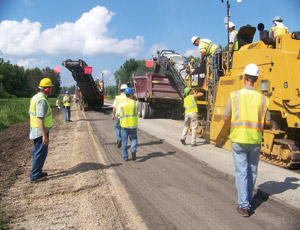While the U.S. Occupational Safety and Health Administration plans to revamp its outdated silica-dust standard, a voluntary partnership of asphalt-paving groups is closing in on recommended methods to cut down the amount of airborne silica dust generated by road-milling machines.

“The goal is to determine exactly how much silica-containing dust asphalt-milling machines generate and to minimize workers’ exposure to it,” says Gary Fore, vice president of the National Asphalt Pavement Association, Lanham, Md. The task force includes government scientists, manufacturers, unions, contractors and industry trade groups.
Last month, the team conducted five days of extensive tests with milling machines donated from Caterpillar, Roadtec, Terex, Volvo and Wirtgen America on a 15-mile repaving project on Highway 47, near Shawano, Wis. Several different configurations of water spray nozzles were tested to see how well they suppressed the dust generated as milling machines ground up the existing asphalt. The tests also evaluated the effectiveness of a vacuum concept. Scientists from the National Institute for Occupational Safety and Health were on hand to collect data.
Researchers evaluated more than 16 combinations of nozzles, spray locations, water pressures and flow rates on the machines as they ground off the top three inches of the asphalt roadway. It was being resurfaced by paving contractor Payne & Dolan, Waukesha, Wis., which set aside areas of the jobsite for testing.
The methods tested were refinements of two basic designs that worked best in the last round of tests, conducted in 2008, researchers say. Each of the five milling machines was equipped with 10 pairs of meters at key locations; one meter in each pair provided a continuous electronic record of the amount of dust passing through a light beam. The other meter separated out dust particles too large to be inhaled, then collected the smaller particles—each less than an eighth of the thickness of a human hair—on a filter. Now, NIOSH is studying the filters to see how much silica they contain.
When NIOSH has crunched the numbers, the task force will go over the latest results and decide on the preferred type of dust controls. “We want to be part of this,” says Roadtec President Jeff Richmond. “At the end of the day, the group will develop the right products and practices to protect the workers—that’s what it’s all about.” The project began in 2003 after a similar partnership in the 1990s produced cuts to asphalt fumes around paving machines (ENR 4/17/00 p. 58).
It is too early to tell whether the controls will be put only on new machines or be made available for retrofit, but task-force members think the cost will be “fairly insignificant because we’re just using an existing system to put more water in critical areas,” says Richmond. The price of a typical milling machine runs from $475,000 to about $650,000.
Although the August test data will not be available until December, previous research indicates the recommended control method will meet current OSHA standards. “Dust typically has been accepted as part of the milling process,” says Emmett Russell, safety and health director for the operating engineers’ union. “We hope this research will raise industry-wide awareness that controling dust is important to worker health.”
Meeting current limits may not be enough. OSHA allows for levels of silica that are 2.5 to 5 times higher than what it is planning in the new standard, NIOSH insiders say. The proposed rulemaking is expected to be issued next February. Besides a lower exposure limit, other changes likely will include updated monitoring methods, medical surveillance requirements, improved worker training and methods to reduce worker exposure.

Post a comment to this article
Report Abusive Comment